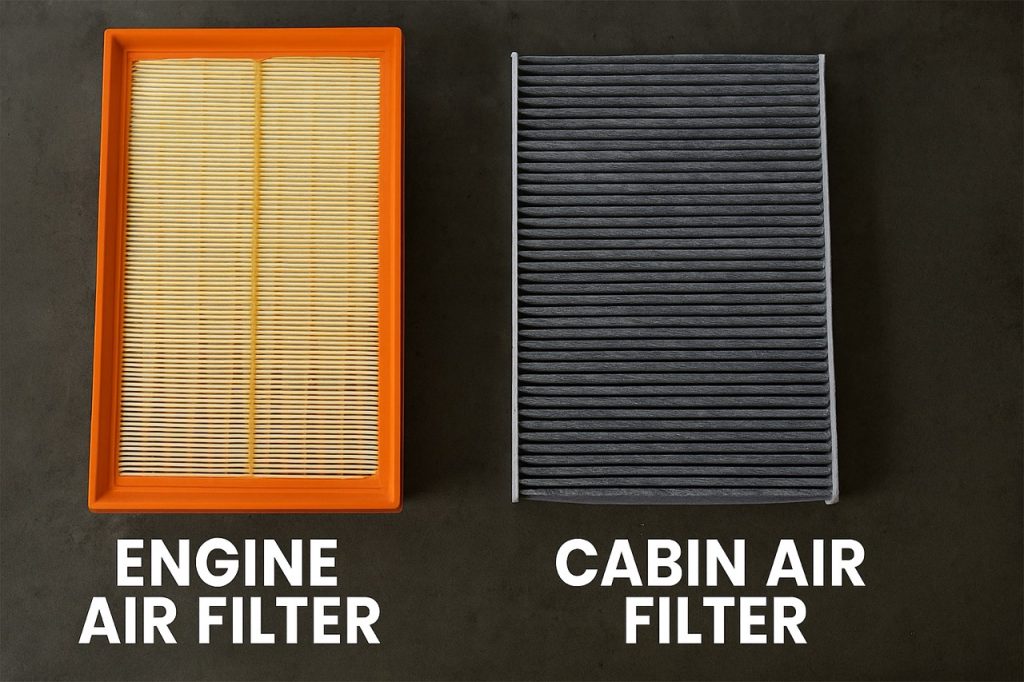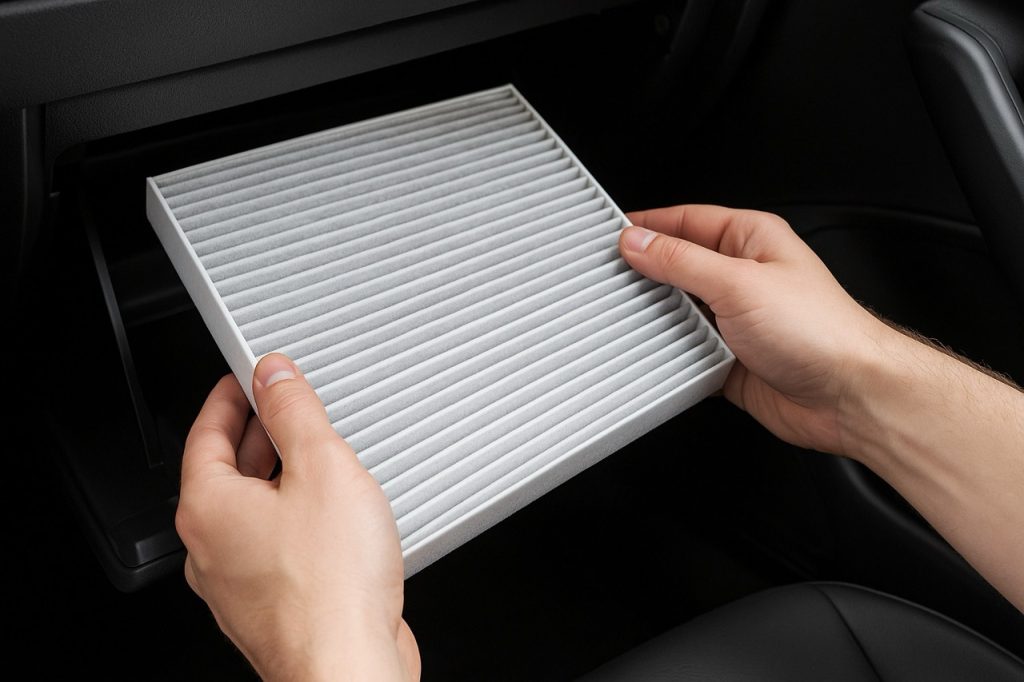Engine Air Filter vs Cabin Air Filter: What’s the Difference? Most people wonder what the real difference between an engine air filter and a cabin air filter is, and if you’re wondering the same, this post is for you. These two filters might look alike, but they do very different jobs inside your car. One protects your engine’s combustion system from dirt and debris, while the other keeps the air inside your cabin clean and breathable. In this article, we’ll break down exactly how both filters work, where they’re located, and how each one affects your vehicle’s performance and comfort.
Finally will we’ll go through some of the most frequent FAQs we get on this topic, such as: how often to replace them, what happens when they get dirty, and the symptoms you’ll notice, how these filters are built, plus a quick DIY guide on how to replace them yourself and to choose the right type for your car. By the end, you’ll know exactly how to keep both your engine and your cabin breathing clean, efficient air all year round. Now let’s get started.

Engine Air Filter vs Cabin Air Filter: What’s the Difference between air filter and cabin filter?
Clean air is essential, not just for your lungs, but for your vehicle’s performance and longevity. Every internal combustion engine relies on a precisely metered air-fuel ratio, and that process begins with clean, filtered air. Likewise, the air inside the cabin should remain free from particulates and allergens to maintain passenger comfort and protect the HVAC components.
While the engine air filter and cabin air filter may appear similar at a glance, both are pleated elements housed in plastic frames; their functions, design criteria, and placement within the vehicle’s systems are fundamentally different. Understanding how each works and when to replace them is key to maintaining both engine efficiency and in-cabin air quality.
What’s the Difference Between a Cabin Air Filter and an Engine Air Filter?


Although both filters share a common objective, trapping airborne contaminants, they operate in entirely different environments and airflow systems.
The engine air filter is positioned in the air intake tract, typically inside the air cleaner housing near the front of the engine bay. Its job is to remove dust, sand, pollen, and other microscopic debris before the incoming air reaches the throttle body and combustion chambers. If unfiltered air entered the cylinders, those abrasive particles could scar cylinder walls, foul mass airflow sensors, and degrade piston rings over time.
The cabin air filter, in contrast, is integrated within the HVAC (Heating, Ventilation, and Air Conditioning) system, often located behind the glove box or under the dashboard. Its purpose is to purify the air that flows into the passenger compartment, capturing fine particulates, soot, and allergens. Many modern cabin filters are multi-layered, incorporating activated carbon or electrostatic fibers that neutralize odors and adsorb harmful gases such as ozone or exhaust fumes.
Structurally, the engine air filter is larger and more rigid, designed to handle higher airflow volumes and withstand vacuum pressures from the intake manifold. Cabin air filters, on the other hand, are smaller and more flexible, optimized for airflow distribution within the HVAC ducts rather than volumetric engine demand.
Finally, serviceability differs: engine air filters are typically easy to access and replace from the engine bay, while cabin air filters may require removing glove box panels or trim pieces, sometimes making replacement a more intricate task.
How Often Should Air Filters Be Changed?
Engine Air Filter:
Most manufacturers recommend replacing the engine air filter roughly every 15,000 miles (24,000 km) or once per year, depending on the operating environment. Vehicles driven in dusty, sandy, or polluted areas may require more frequent changes. A clean air filter maintains optimal air-fuel ratio, engine breathing efficiency, and fuel economy by ensuring unrestricted airflow to the intake manifold.
Cabin Air Filter:
Cabin air filters typically last longer, approximately every 20,000 to 30,000 miles or every two years. However, longevity depends heavily on local air quality and seasonal conditions. Drivers who frequently operate in urban traffic, near construction zones, or pollen-heavy regions should inspect and replace their cabin filters more often.
Regular replacement ensures consistent HVAC airflow, prevents fogging issues on windows, and maintains fresh cabin air free from odor-causing bacteria.
The Effects of a Dirty Air Filter or Cabin Air Filter
Both filters continue functioning as they accumulate dirt, but once airflow becomes restricted, system performance degrades measurably.
Dirty Engine Air Filter Symptoms:
- Reduced Fuel Economy: A restricted filter lowers intake pressure, forcing the engine control unit (ECU) to enrich the fuel mixture to maintain power.
- Power Loss or Sluggish Acceleration: Insufficient airflow limits combustion efficiency, reducing torque and throttle response.
- Rough Idling or Misfires: A severely clogged filter can cause uneven air delivery, disrupting combustion stability.
- Check Engine Light: The Mass Air Flow (MAF) sensor may detect abnormal readings, triggering diagnostic fault codes.
Dirty Cabin Air Filter Symptoms:
- Weak HVAC Airflow: The blower motor must work harder to push air through a clogged filter, leading to reduced cooling and heating performance.
- Unpleasant Odors: Trapped organic material becomes a breeding ground for mold and bacteria.
- Poor Defrosting Efficiency: Reduced airflow through the evaporator and heater core can slow windshield clearing.
- Whistling or Fan Noise: Debris buildup may cause the blower wheel to become unbalanced.
Both filter types should be visually inspected; any accumulation of leaves, dust, bugs, or oil residue within the pleats indicates that replacement is overdue.
Can I Replace Air Filters Myself?
For most vehicles, replacing both the engine air filter and cabin air filter is a straightforward DIY procedure requiring only basic tools.
Engine Air Filter Replacement:
Locate the air cleaner assembly, usually a plastic box near the front or side of the engine bay. Release the metal clips or screws securing the cover, remove the old filter, and install the new one, ensuring the sealing edges are seated correctly to prevent unfiltered air bypass.
Cabin Air Filter Replacement:
Identify the filter compartment, typically behind the glove box or under the dashboard. Remove the access panel, slide out the old filter, and note the airflow direction arrows before inserting the new one. Secure the cover and reassemble the glove box or trim panels.
A clean air filtration system not only improves comfort and performance but also extends component life, from MAF sensors to blower motors.
FAQ / People Also Ask
What is an engine air filter, and what does it do?
An engine air filter is a pleated barrier constructed of cellulose, synthetic fibers, or foam that removes dust and debris from incoming air before it reaches the combustion chamber. It ensures optimal air density and protects internal components from abrasive wear.
What is a cabin air filter, and what does it do?
A cabin air filter is part of the HVAC intake system that cleans the air entering the passenger compartment. It captures pollutants, pollen, and odors, ensuring a healthy and comfortable environment inside the vehicle.
Where are the engine air filter and cabin air filter located in a vehicle?
The engine air filter resides in the air cleaner housing within the engine bay, typically connected to the intake duct. The cabin air filter is located within the HVAC housing, most commonly behind the glove box or near the firewall.
How often should engine air filters and cabin air filters be changed?
Replace the engine air filter annually or every 15,000 miles, and the cabin air filter every two years or as specified in your vehicle’s maintenance schedule.
Can a dirty air filter harm my engine or cabin air system?
Yes. A clogged engine air filter can cause poor fuel economy, misfires, and internal wear from unfiltered debris. A dirty cabin air filter won’t damage the HVAC system directly, but can reduce airflow efficiency and promote bacterial growth.
Are there different types of engine air filters and cabin air filters?
Absolutely. Engine filters include dry paper, oiled cotton, and foam performance filters. Cabin filters come in standard particulate, activated carbon, and HEPA-grade variations, each designed for different filtration needs.
